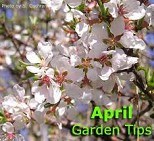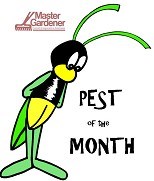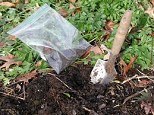EAST LANSING, Mich. — Why are my crabapples looking so bad? This question has been asked repeatedly by folks contacting the Michigan State University Extension Lawn and Garden Hotline this summer. The fungus, Venturia inaequalis, known as apple scab, is a leaf spot disease that can cause serious leaf drop on susceptible crabapple trees.
Lengthy periods of rain this past May provided conditions for apple scab spores to develop. Scab-infected leaves from the previous season, left on the ground around the tree are the source of fungal spores that can infect the crabapple the next spring. Spores from these old leaves are carried on air currents to new developing leaves. This primary infection produces olive colored spots on leaves.
As the fungus grows on the leaves, new spores are produced starting a secondary infection of leaves and fruit. Damaged leaves become curled and yellowish with lesions, eventually turning brown. Heavy disease pressure leads to premature leaf drop. Fruit infected by apple scab develops raised scab-like lesions and severely infected fruit will drop from the tree.
Crabapple varieties can vary greatly in their susceptibility to apple scab (Venturai inaequalis). Susceptible trees are often nearly without leaves by August, reducing the plant’s ability to produce and store energy for future growth. This weakens the tree and reduces its vigor and ability to overcome environmental stresses. A tree in my old backyard in Livonia would lose nearly all of its leaves during the summer, but still continued to produce beautiful flowers every spring. It survived the impact of apple scab for over 50 years. Sitting in the back corner of the property it was easy to overlook the lack of leaves during the summer.
What to do about apple scab
A few questions need to be considered when deciding how to manage this leaf spot disease. Does it occur every year? If it does occur every year, how serious is the impact? Does the tree retain most of its leaves?
Of course one way to manage it is to do nothing. This works well if you have a crabapple like the one in my backyard, where the loss of leaves was not so noticeable and it did not outweigh the beauty of the spring flowers. For trees that are susceptible and retention of leaves is the goal, this would require applying fungicides at the correct time. Fungicides work best as preventative treatments with a spray program that starts at the first sign of leaves in spring and continues through the humid weather and moderate temperatures of spring into early summer. University of Minnesota Extension provides detailed information on managing apple scab at “Managing apple scab on ornamental trees and shrubs”.
Whether you decide to use a fungicide or not there are a few steps that may help reduce the spread of the fungus. Trim trees in early spring to allow good air circulation, which reduces the time plants remain wet after a rain or from dew. Evaluate the surrounding landscape for overgrown trees and shrubs that are shading, growing into or are crowding the susceptible crabapple. Do some plants need to be trimmed back away from the tree to increase light and air circulation? Also, make sure sprinklers are not wetting the leaves of the crabapple creating conditions where apple scab thrives.
Sanitation can help reduce the source of the fungus. Pickup and dispose of leaves and fruit infected by the fungus that drops from the tree. This will not eliminate all sources of the fungus since spores can be carried by the wind from apples and crabapple leaves in neighboring yards, but it may reduce the early impact of the disease.
Another choice would be to remove a very susceptible crabapple and replace it with a resistant variety. With over 100 varieties available in the nursery industry, you can pick and choose the size and shape of the plant, flower and fruit color, fruit size and also resistance to the apple scab pathogen. For a list of apple scab resistance crabapples see the Purdue Extensionpublication “Crabapples Resistant to Apple Scab and Japanese Beetle in Indiana”.
— Bob Bricault, Michigan State University Extension





